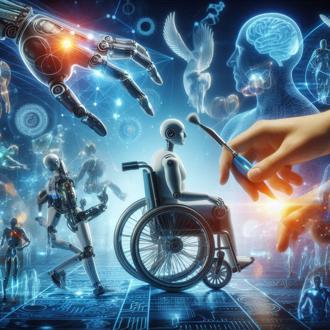The Future of Rehabilitation: Innovative Technologies for Enhanced Recovery
Monday, 29 July,2024
Introduction
In today's ever-evolving world, technology is constantly pushing boundaries and transforming industries. The field of rehabilitation is no exception. Innovative solutions for human-robot interaction (HRI) are emerging as revolutionary tools with the potential to significantly improve recovery processes for patients with various physical limitations. This blog post dives deep into this exciting field, exploring functionalities, benefits, and real-world applications of HRI technologies in rehabilitation.
What is Human-Robot Interaction (HRI) in Rehabilitation?
HRI in rehabilitation can be defined as the collaborative environment where humans and robots work together to achieve therapeutic goals. Robots can act as assistants, providing support, guidance, and feedback during exercises. Imagine a robotic arm gently assisting a stroke patient with regaining arm movement, or a virtual reality system creating a safe and interactive environment for gait training.
Use Cases and Industry Applications:
HRI solutions transcend different rehabilitation needs and offer a multitude of use cases:
Physical Therapy: Rehabilitation robots can provide targeted exercises, personalized training programs, and real-time feedback, assisting therapists in delivering more effective treatments. This can lead to significant improvements in patient mobility, strength, and coordination.
Neurological Rehabilitation: Technologies like virtual reality can create immersive environments for patients to practice movements in a safe and controlled setting. This approach enables patients with neurological conditions to re-train their brains and improve motor skills.
Post-Surgical Rehabilitation: Robotic exoskeletons can offer physical support and guidance, allowing patients to regain lost mobility and function after surgery, facilitating a faster and more effective recovery process.
Benefits:
HRI solutions offer a compelling set of advantages for the field of rehabilitation:
Improved Patient Outcomes: Studies show that incorporating HRI technologies in therapy can lead to faster recovery times, enhanced patient engagement, and a higher success rate in achieving therapeutic goals.
Increased Efficiency for Therapists: Robots can handle repetitive tasks, freeing up therapists' time to focus on individual patient needs and provide more personalized care.
Enhanced Accessibility: HRI technologies can make therapy more accessible to patients in remote areas or those with limited mobility.
Reduced Treatment Costs: While the initial investment might be significant, HRI solutions can lead to cost savings in the long run by reducing overall treatment duration and hospital stays.
